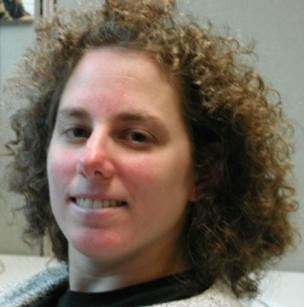 |
| Sara W. Lazar Photo courtesy of Sara W. Lazar |
Sara W. Lazar is a neuroscientist and meditator. You don't often hear those in the same sentence. But the life of this one-time PhD student of molecular biology changed course when she discovered yoga and meditation while recovering from a running injury. That was 12 years ago and now she is a cutting edge researcher in the field of neuroscience. She's focusing on the effects of meditation on the brain. "While in grad school I started practicing yoga and meditation, and found it to be incredibly helpful. I was less stressed, more focused and it really changed my perspective on a lot of things. I decided I would rather do research on meditation than on bacteria, so after I got my PhD, I found a lab that was willing to train me in neuroscience and let me do a small meditation study."
That lab happens to be in the Psychiatry Department at Massachusetts General Hospital. The focus of her research is the neurobiology of meditation. She uses functional magnetic resonance imaging (fMRI) to investigate the neural correlates of changes in autonomic function during the practice of meditation. Dr. Lazar goes on to explain, "fMRI is a special way of using a MRI scanner to look at how the brain works. Normal MRI takes one really nice picture of your brain, with lots of details that are easy to see. fMRI is sort of like a movie - it takes special pictures of blood flow in the brain. The parts of the brain that are most active at any point will have the most blood flow, so we take pictures of the person meditating and resting, and then use a computer to determine where in the brain there is the most blood flow during meditation compared to rest." Dr. Lazar explains that an MRI scanner is sort of like an X-ray, but it allows us to take pictures of the brain that have much more detail than any X-ray. MRI's are also less harmful because they use radiowaves instead of radiation. A computer takes those radiowaves and turns them into pictures that look just like normal pictures of a brain.
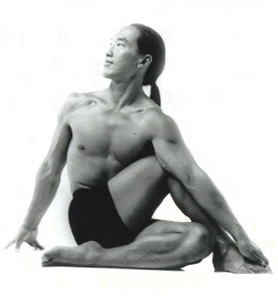 |
| A yoga master in action (kalani.com/yoga) |
I asked Sara to describe how yoga and meditation work. She replied, "Not a simple question! Yoga and meditation have MANY positive effects but we don't really know for sure how any of the benefits are brought about. Some of it is the deep relaxation that accompanies these practices - stress hormones seem to get turned down while we practice, and perhaps after much practice are less likely to get turned up so high when stressful things happen. Some of the benefits are from the enhanced concentration that is required to stay focused on the yoga posture or breathing sensations during practice. Again, people who meditate say that this helps them stay focused even when they are not practicing."
"Finally, some of the benefits are probably from a skill called "mindfulness." This is sort of hard to describe. Most of the time as we walk around, the little voice in our head jabbers away and makes all sorts of comments about our experience. We usually believe that the small voice is "me," but Eastern philosophy disagrees. When you are really engrossed in something, like say a really good movie - the little voice will be quiet as we watch and absorb all the action. No judgments are being made, no thinking about how what you are watching will impact you. The goal of mindfulness meditation is to become aware of that little voice and step back from it, see if you can experience everything in that way, by just watching and listening, without getting caught up in what the little voice might be saying."
"This is important, because for some people, the voice can cause much grief and stress. For instance, when you see a really yummy desert, just noticing the color and texture of the food, and not getting caught up in "I really want that, but it has a million calories and I'll gain 10 pounds if I eat it. I've been good so maybe just a few bites as a treat. Maybe if I work-out tomorrow, I'll burn off the calories...." When you distance yourself from the chatter, you often start to realize that you may not even really be hungry, or that you want something else. Or, if you do decide to just "have a bit," you can often use mindfulness to eat just until you have had enough, instead of eating the whole thing out of habit, etc. Some people really beat themselves up, or worry excessively about things, so by learning to be mindful, you start to see that the chatter has little real content, and the stress it causes starts to melt away."
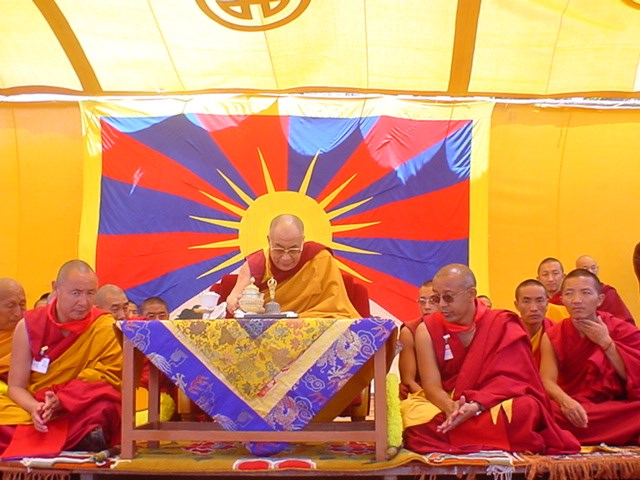 |
| His Holiness the 14th Dalai Lama (westkameng.nic.in) |
Sara practices something called Buddhist "Insight Meditation." Unlike the more commonly known form of meditation, TM that uses a mantra (a word that is repeated over and over), Insight Meditation focuses on the sensations of breathing. You focus on the rise and fall of the belly, the flow of air in and out of the nose. Dr. Lazar told me that, "TM places a strong emphasis on attention, while Insight places a strong emphasis on mindfulness (both forms of meditation promote both qualities, but the emphasis is different, sort of like running vs. swimming - you need strong arm and leg muscles for both activities, but running emphasizes legs and swimming emphasizes arms."
This past November, His Holiness the 14th Dalai Lama gave a talk entitled, "The Neuroscience of Meditation," to an eager audience of 14,000 at a meeting of the Society for Neuroscience in Washington, DC. In a quote cited in Scientific American's February, 2006 issue, the Dalai Lama emphasized that religion can help science, not just hinder it. In particular, he urged neuroscientists not to discount the role of Buddhist traditions on the brain, specifically meditation. "Try to find reality with an open mind," he said, referring both to investigations in science as well as to studies in Buddhist thought. "Without investigation, we can't see reality."
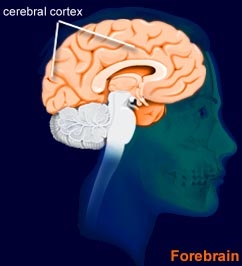 |
| The cerebral cortex....the brain (brainexplorer.org) |
At this same meeting Sara Lazar presented the reality she discovered from her study comparing long-term meditators to non-meditators. "We used the MRI to measure thickness of the cortex - the outer gray matter layer of the brain - in twenty people who practice Buddhist 'Insight' meditation, which focuses on the cultivation of mindfulness. Two of the subjects were full-time meditation teachers and the rest were typical professionals with varied careers such as law, healthcare, and journalism. On average, these participants had 9 years of meditation experience and practiced 6 hours per week. Fifteen control subjects had no meditation or yoga experience. Brain regions associated with attention and sensory processing were thicker in meditators than in the controls. In particular, a region called the insula was much thicker in the meditators. The insula is like a switchboard, connecting brain regions involved in emotions with those involved in thoughts and decisions. We believe this may contribute to stress reduction - thicker cortex probably means that this area is better able to coordinate these regions, thereby helping to resolve difficult emotional problems." Sara was surprised by one of her findings, "In one of the regions, the cortex of the meditators did not get thinner with age, as is usually seen in most people. This suggests that meditation practice may help slow down some of the cognitive decline that occurs with age (i.e., forgetting names and being a little slower to figure things out). But this must be interpreted carefully, because it was a small study and we did not test people for cognitive abilities."
What does a typical day, including spiritual practices look like for Dr. Sara Lazar? "I practice about 3 times a week. On those days I get up about half an hour earlier to practice. I also practice in a group one night a week, and take a yoga class on the weekends. I have a child, so my work hours are strictly 9-5. This type of science just uses computers, so I spend most of my day in front of one, and the rest of the time talking with other scientists and people in the lab. Once a week we put people in the scanner and run various tests on them (i.e., testing how well they can do various tasks that we think are related to the thickening of their brains)."
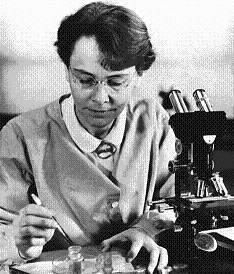 |
| Barbara McClintock, Cold Spring Harbor Laboratory (www.cshl.edu) |
I asked Sara who her hero was and why.
"Barbara McClintock. She was a scientist who studied maize genetics, and was the first person to propose that chromosomes may not be stable (i.e., that pieces of it can jump around from place to place, causing surrounding genes to be turned on and off). Nobody believed her, but she stood by her work and ultimately won a Nobel Prize."
What advice do you have for girls thinking about getting into a career in science?
"Go for it! It can be challenging at times, but it is totally worth it. Also, for the most part, it allows you to have a flexible career when you need it (i.e., to have kids). I have found that men and women tend to think about scientific questions differently, and sometimes use different logic/methods to answer them. This is very beneficial for the field, having multiple points of view. It is important to remember this, to realize you can make important contributions, because sometimes men don't initially understand and appreciate alternate points of view."
Sara Lazar continues to forge ahead in her quest to prove the scientific benefits of meditation and spiritual practices. Her original yoga teachers "cure-all claims" that propelled Sara onto her current path of research are still mostly unproven but there are clear correlations. According to Sara, "The science is still lacking for most illnesses. It is clear that it helps reduce stress, anxiety, depression and pain, but beyond that it is less clear. Stress exacerbates all disease, and meditation can counter the effects of stress, so for all other diseases, it is not yet clear if it really does something specific for those diseases, or whether it is just 'side effects' of stress reduction."
For people interested in learning more about meditation and yoga, check out the sites below or look in your local listings for classes. Two authors Sara recommends on the subject of meditation are: the Buddhist Nun, Peme Chodron, and Sharon Salzberg, a leading insight meditation teacher and spirituality writer.
And remember. Don't forget to Breathe.
Page created on 3/8/2006 2:33:47 PM
Last edited 1/9/2017 9:55:40 PM
